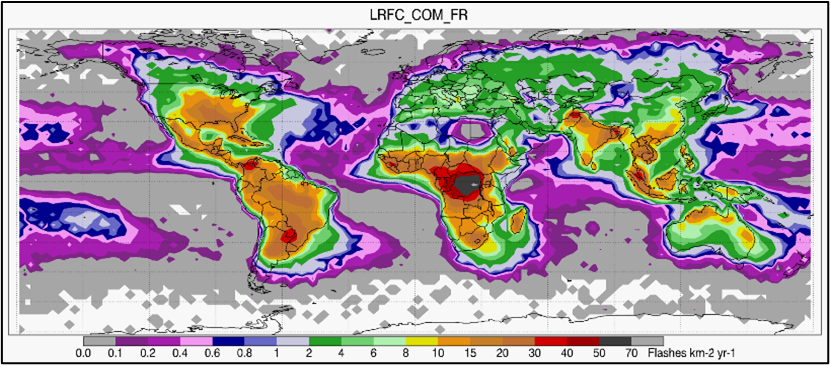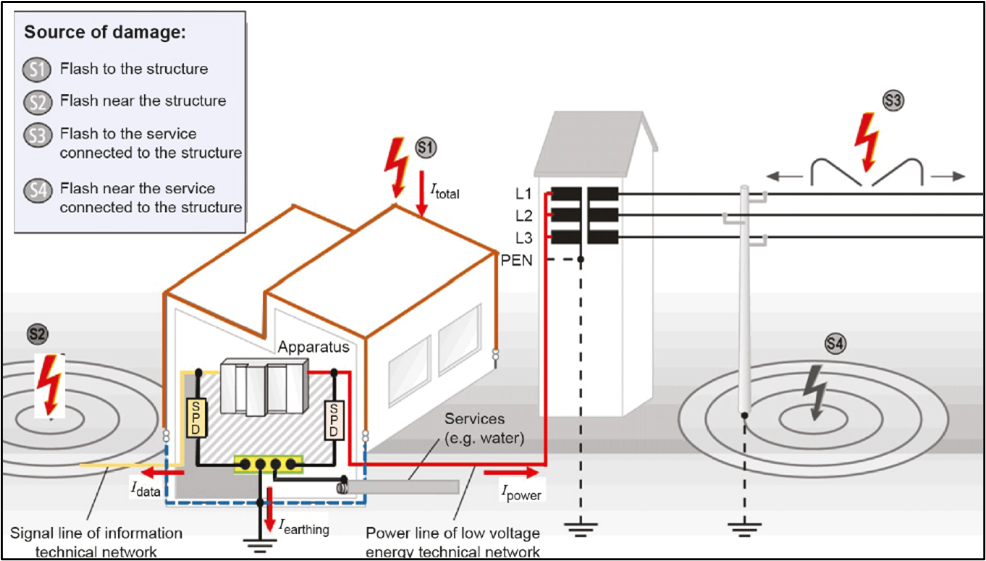Operational continuity is essential for any data centre, and lightning strikes pose one of the most unpredictable threats. The protection of data centres requires a comprehensive system that combines external and internal protection and early storm detection.
Approximately 100 lightning strikes occur every second across the planet—about 1.2 billion per year—25% of which reach the Earth’s surface (Image 1). Lightning discharges are natural phenomena and cannot be avoided, as stated in the introduction of the international standard IEC 62305-1:2024. However, with the implementation of appropriate solutions, their negative effects can be mitigated.

Image 1: Source: NASA – Global lightning flashes per year and km²
Data centres are critical infrastructures where lightning strikes, whether direct or indirect, can cause severe system failures and compromise service continuity. The first step in preventing damage is to perform a lightning risk assessment for the data centre. For this purpose, INGESCO provides its online software CALCULUS, based on IEC 62305-2, which determines the need and level of protection and generates a technical report in the selected language.
Once the risk has been analyzed, the next step is to implement a Lightning Protection System (LPS), a comprehensive solution that combines external protection, internal protection, and early warning detection systems, all working together to mitigate potential sources of damage (Image 2).

Image 2: Source: IEC 62305-4 – Sources of damage in a structure and current distribution
At INGESCO, we address this need through the design of comprehensive lightning protection systems that combine external, internal, and early detection solutions , all tailored to the specific characteristics of each project and the regulations in force in every country. We carry out customized studies that ensure an effective, safe, and compliant installation, optimizing protection at every critical point of the infrastructure.
External Lightning Protection
This is one of the most critical elements, designed to prevent direct lightning strikes on structures. The recommended external protection systems include:
Early Streamer Emission (ESE) Air Terminals or conventional lightning rods: Their purpose is to intercept lightning strikes and prevent them from hitting the structure directly.
Faraday Meshes: Designed to cover and shield the structure, minimizing the penetration of lightning energy into the data centre.
Efficient Earthing Systems: Ensure the safe dissipation of lightning current into the ground through low-impedance designs suitable for high-frequency lightning currents.
These solutions must be designed in accordance with international standards such as the IEC 62305 series, ensuring a proper distribution of capture, shielding, conduction, and dissipation elements.
Internal Protection Against Transient Overvoltages
Even with external protection in place, lightning effects can still induce transient overvoltages capable of damaging sensitive equipment. To prevent this, it is essential to shield all cables running outside the data centre and install Surge Protective Devices (SPDs) in both power and data/telecommunication networks:
Electrical Panels: Installation of Type 1 SPDs at the service entrance, Type 2 at sub-distribution boards, and Type 3 at sensitive electronic equipment.
Telecommunication and Data Lines: Protection of servers, switches, and storage devices.
Equipotential Bonding and Earthing Systems: Preventing potential differences between various points within the data centre.
Proper selection and installation of these devices significantly reduce the risk of damage to technological infrastructure.
Storm Detection and Alarm Systems
Their function is to anticipate electrical storms and activate preventive protocols. According to IEC 62793, the technologies include:
Electrostatic Field Sensors, such as the PREVISTORM® Thunderstorm Warning System, which detects the presence of electrical charge in the atmosphere and provides early alerts.
Lightning Detection Networks, systems that monitor real-time electrical activity and provide information through online platforms.
These systems allow operators to make informed decisions, such as:
- Activar generadores de respaldo y redundancia energética.
- Desconexión de equipos sensibles para trabajar en isla.
- Implementar procedimientos de respaldo de datos en servidores alternativos.
INGESCO Solution: Technology, Safety, and Continuity
Protecting a data center against lightning requires a comprehensive, regulation-backed strategy. INGESCO offers a complete solution that includes:
- Risk assessment with CALCULUS
- Certified external protection
- Internal protection tailored to each environment
- Early storm warning systems
All supported by a technical team with over 50 years of experience and thousands of installations worldwide.
Want to protect your data center?
Contact us to design a customized solution and ensure the continuity of your operations against any atmospheric discharge.

